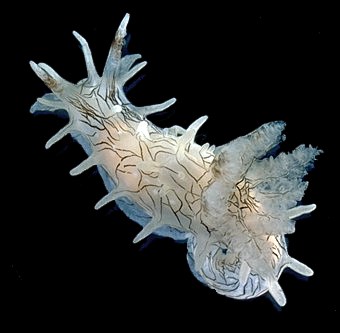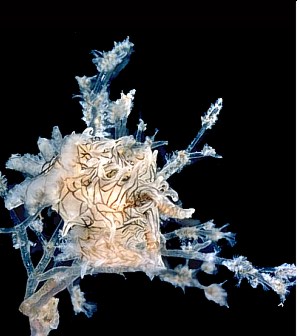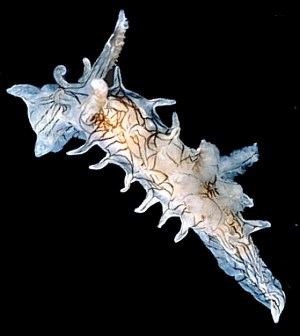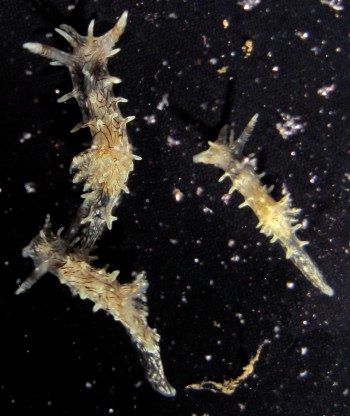
Okenia pellucida
Burn, 1967
Order: NUDIBRANCHIA
Suborder: DORIDINA
Superfamily: ANADORIDOIDEA
Family: Goniodorididae
DISTRIBUTION
New Zealand, Australia (NSW, Qld, WA), Hawaii, Japan, Palmyra Atoll, Malaysia; United Arab Emirates (See Rudman, 2004).
PHOTO
Angourie, North Coast, New South Wales, Australia. March 1982, 3 specimens 8, 12 & 20mm long, on Zoobotryon. PHOTOS: Bill Rudman.
The animal is elongate with up to 11 or 12 lateral papillae along each side of the mantle edge, which forms a distinct ridge around the edge of the notum. There are also a few papillae [5-6] on the dorsum, but they do not seem to form a consistent pattern. The head is quite separate from the foot and bears large triangular oral tentacles. The rhinophores are about twice the length of the mantle papillae. The gills are bipinnate and form a circle, or incomplete arch around the anal papilla.
The whole of the body is translucent white with a network pattern of thin dark brown lines covering all parts of the dorsum, the foot, the head and the rhinophores stalk. In some specimens the lines also extend to the tips of the mantle papillae. There is often a brownish band around the bottom half of the rhinophore club, and the gills have a thin brown line along each rachis.
The anatomy of this species has recently been re-examined (Gosliner, 2004; Rudman, 2004). Photos of the radula are posted separately [see message #12648 ]. Since its original discovery in Sydney Harbour 40 years ago, this species is now known from much of the Indo-West Pacific. It is always associated with the ctenostome bryozoan Zoobotryon verticillatum on which it feeds and lays its egg masses. This bryozoan is a common fouling organism which suggests that wide distribution of this nudibranch has probably been aided by shipping.
- Burn, R. (1967). Descriptions of two new species of Okenia (Nudibranchia, Doridacea) from south-eastern Australia. Proceedings of the Royal Society of New South Wales 1965-66: 52-57.
-
Gosliner, T. M. (2004) Phylogenetic Systematics of Okenia, Sakishimaia, Hopkinsiella and Hopkinsia (Nudibranchia: Goniodorididae) with descriptions of new species from the tropical Indo-Pacific. Proceedings of the California Academy of Sciences, 55: 125-161.
-
Rudman, W.B. (2004) Further species of the opisthobranch genus Okenia (Nudibranchia: Goniodorididae) from the Indo-West Pacific. Zootaxa, 695: 1-70.
ARCHIVE NOTE: An earlier edition of this Fact Sheet [5 Oct 1999] is available on request.


Rudman, W.B., 2004 (December 21) Okenia pellucida Burn, 1967. [In] Sea Slug Forum. Australian Museum, Sydney. Available from http://www.seaslugforum.net/find/okenpell
Related messages
Okenia pellucida from Ratnagiri, India
April 25, 2010
From: Vishal J. Bhave

Dear sir,
Seen those tiny slugs - Okenia pellucida - on a bryozoan looking like algae possibly Zoobotryon sp.; which was on the wall of rock pool. We counted around 24 individuals and seen white irregular tubular egg cases on branches of bryzoan.
As you have mentioned in one of your earlier messages the bryozoan was overgrown with green alga.
Locality: Mandavi, Ratnagiri, 10-70 centimeters, Maharashtra, India, Arabian Sea, 22 February 2010, Intertidal, deep rockpool, with loose rocks,. Length: 7-12 mm. Photographer: Vishal Bhave.
Vishal Bhave
vishalbhave@gmail.com



Dear Vishal,
It's certainly Okenia pellucida, and good to fill in another gap in its known distribution.
Best wishes,
Bill Rudman
Re: Okenia pellucida from eastern Australia
February 28, 2008
From: Leanne & David Atkinson

Concerning message #21335:
Dear Bill,
We encountered Okenia pellucida at Port Stephens again. We found it by the prolific egg rings in the host bryozoan. The Okenia were difficult to see because they were so tiny. We used the minimum focus 1:1 of our macro lens to even see them. We could see this pair with eggs actually wrapped around them and think we have caught them in the act of laying the eggs. What do you think?
Locality: Fly Point Port Stephens, Port Stephens-Great Lakes Marine Park, 10 metres, New South Wales, Australia, Pacific, 23 February 2008, Sandy bottom scatteres sponges, gorgonians, bryozoans, ascidians and soft corals. Length: approximately 5mm. Photographer: Leanne & David Atkinson
Best wishes,
Leanne & David Atkinson
atk@hunterlink.net.au



Dear Leanne & David,
Thanks for these excellent photos. I can't be 100% sure they are laying this egg ribbon but it certainly looks like their egg ribbon
Best wishes,
Bill Rudman
Okenia pellucida from eastern Australia
January 31, 2008
From: Leanne & David Atkinson

Concerning message #19476:
Dear Bill,
It has been some years since we encountered Okenia pellucida at Port Stephens but we have found it again this season. The prolific egg rings in the host bryozoan like a decorated Christmas tree drew our attention. The Okenia were difficult to see because they were so tiny. We used the minimum focus 1:1 of our macro lens to even see them. When we put the images on the computer it was easy to see that the host was covered with an "infestation" of them. Presumably the eggs belong to this species but we're not sure that we actually captured any in the process of laying them. You don't seem to have any egg photos for this species so we thought this might be of interest.In the process of sending this in we noticed the notes on Okenia zoobotryon and realised we had seen a couple of those on the same host so we will send them in a separate message [#21336]. The majority of nudibranchs we could see on the bryozoan were Okenia pellucida.
Locality: Halifax Sponge Gardens, Port Stephens - Great Lakes Marine Park, Port Stephens, 15 metres, New South Wales, Australia, Pacific, 30 December 2007, Sandy bottom, scattered sponges, ascidians, soft corals, kelp and bryozoans.. Length: 5 to 10 mm. Photographer: Leanne & David Atkinson.
Best wishes,
Leanne & David Atkinson
atk@hunterlink.net.au



Dear Leanne & David,
Okenia zoobotryon gets it name from the bryozoan, Zoobotryon verticillatum, on which it feeds. Okenia pellucida also feeds on this bryozoan and your photos are very welcome. Both species are very dependent on the presence of the bryozoan, which is a well-known fouling organism throughout the world. It is usually one of the first organisms to colonise cleared spaces, but it is not very good at retaining its territory, so it is quickly overgrown or eaten by slower growing but more aggressive plants and colonial animals. Because of its fleeting presence, the species of Okenia which feed on it are rare and short-lived visitors to any particular spot, but when they are present they are usually in large numbers.
Best wishes,
Bill Rudman
Okenia pellucida from Lembeh,North Sulawesi
June 4, 2007
From: Francis & Pirjo Pellet

Hi Bill,
First record of Okenia pellucida from North Sulawesi on the forum.
We found it (night dive) on its bryozoan food in shallow water on the wall of Nudi Falls.
Locality: Nudi Falls, 5m, Lembeh Strait, North Sulawesi, Indonesia, 16 October 2006, Reef wall. Length: 8 mm. Photographer: Francis Pellet.
Best wishes
Francis & Pirjo
pirjo.pellet@free.fr
Pellet, F. & P., 2007 (Jun 4) Okenia pellucida from Lembeh,North Sulawesi. [Message in] Sea Slug Forum. Australian Museum, Sydney. Available from http://www.seaslugforum.net/find/19476Dear Francis & Pirjo,
Thanks for this. It's nice to get another record from tropical waters. It seems to be on its usual food. the ctenostome bryozoan Zoobotryon verticillatum.
Best wishes,
Bill Rudman
Radula of Okenia pellucida
December 21, 2004
From: Bill Rudman

To accompany the new Fact Sheet on Okenia pellucida, here is some information on the radular morphology of this species.
PHOTOS: Scanning electron micrographs of radula. Two views of right side of radula showing bicuspid tip to inner teeth. Angourie Pool, nthn New South
Wales, Australia, 11 March 1982. AM C132964. Scale bar = 10 µm. Photo: G. Avern.
The radular formula of an animal 20 mm long alive, was 26(+1) x 1.1.0.1.1. The innermost tooth has a broad base and a long elongate blade which divides into two pointed cusps. The inner cusp has approximately 12 long, pointed denticles along its inner edge. The much smaller outer teeth have a broad quadrangular base with a large recurved pointed cusp.
Bill Rudman
Rudman, W.B., 2004 (Dec 21) Radula of Okenia pellucida. [Message in] Sea Slug Forum. Australian Museum, Sydney. Available from http://www.seaslugforum.net/find/12648Bryozoan food of Okenia pellucida
February 29, 2000
From: D.& L. Atkinson

Hi Bill,
Thanks for the identification of Okenia pellucida.
Here is the "big picture" of the bryozoan? It looks more like an algae to me?
David & Leanne
atkin@hunterlink.net.au
Atkinson, D.& L., 2000 (Feb 29) Bryozoan food of Okenia pellucida. [Message in] Sea Slug Forum. Australian Museum, Sydney. Available from http://www.seaslugforum.net/find/1987
Dear Dave & Leanne,
Thanks for the photo. Yes it does look like a plant. In bryozoans, each individual animal or zooid lives in a flasklike container called a zooecium. In ectoproct bryozoans like Zoobotryon the plant-like structure is a scaffolding or skeleton on which the individual zooecia are clustered together in small groups. It is these zooecia that Okenia eats so in a well-grazed colony of Zoobotryon there are often very few clusters of zooecia left to see. In my photo alongside you can see clusters of the flask-shaped zooecia. In some clusters the feeding tentacles of the zooids are extended so they look quite like hydroid polyps. Each cluster is approximately 5mm long.
Best wishes,
Bill Rudman.
Okenia pellucida from New South Wales
February 23, 2000
From: D.& L. Atkinson


Hi Bill,
Judi Martin found the attached nudi on some algae? at 8m at Little Beach (Port Stephens, New South Wales) and directed us to them. They are only about 4mm in length and are quite numerous on this one "bush". I can't find anything like it in our books.
David & Leanne Atkinson
atkin@hunterlink.net.au
Atkinson, D. & L., 2000 (Feb 23) Okenia pellucida from New South Wales. [Message in] Sea Slug Forum. Australian Museum, Sydney. Available from http://www.seaslugforum.net/find/1939Dear Dave,
Your slug is Okenia pellucida and the 'algal bush' it is on is a colony of the arborescent bryozoan Zoobotryon on which it lives and feeds. Have a look at my comments below concerning it lifestyle.
Best wishes,
Bill Rudman.
Re: Okenia pellucida
October 8, 1999
From: Tomohiko Kurihara
Dear Bill.
Thank you very much for your reply.I am very happy that you have put my message on your Sea Slug Forum. I really appreciate it very much. I am going to send email about other sea slug.
Talk to you soon.
Please come to Japan one day and vist OSEZAKI.
Best regards.
Tomohiko Kurihara.
kappa-kuri@tokai.or.jp
Kurihara, T., 1999 (Oct 8) Re: Okenia pellucida. [Message in] Sea Slug Forum. Australian Museum, Sydney. Available from http://www.seaslugforum.net/find/1409Dear Tomohiko,
I am very happy that you sent us the information on Okenia and I look forward to any more messages and photos you are willing to send us. The great work of Dr Kikutaro Baba and other Japanese scientists make the Japanese fauna of great interest to all opisthobranch research workers. Any photos of Japanese species, not just those you can't identify, would be welcome.
Best wishes,
Bill Rudman.
First record of Okenia pellucida from Japan
October 6, 1999
From: Tomohiko Kurihara

Dear Bill.
My name is Tomohiko Kurihara. Expert diver in Japan. I've recently found this great nudibranch. Have you ever seen it? The locality is OSE, a famous diving spot in Japan. This nudibranch was waving with seaweed. This is the first time I have seen it and I've been scuba-diving 15 years. I was excited! I think it is a kind of Polycera. But please let me I know what correct name is.
I introduce some nudibranchs on my homepage at http://www.ne.jp/asahi/kappa-kuri/miyamoto/OSEHOO/umiushi.html.
Best regards.
Tomohiko Kurihara
kappa-kuri@tokai.or.jp
Kurihara, T., 1999 (Oct 6) First record of Okenia pellucida from Japan. [Message in] Sea Slug Forum. Australian Museum, Sydney. Available from http://www.seaslugforum.net/find/1399Dear Tomohiko,
This is a very interesting find. It is the nudibranch Okenia pellucida which was previously only known from Australia and northern New Zealand. It feeds exclusively on the plant-like bryozoan Zoobotryon. Since Zoobotryon is a fouling species, growing on the bottom of boats and found worldwide, it is possible that this species has been distributed around the world the same way. It has been suggested by Willan & Coleman, 1984 that Okenia zoobotryon (Smallwood, 1910), from Bermuda, which is also found on Zoobotryon, might be the same species, but it seems to have a colour pattern of spots, rather than lines.
I think the seaweed you found your animal on was in fact this bryozoan Zoobotryon.
Have a look at Okenia mija for another photo of a species of Okenia living on Zoobotryon. By coincidence the Forum has just had a message about Polycera hedgpethi, another nudibranch which also lives and feeds on fouling bryozoans, and also has a wide distribution.
Best wishes,
Bill Rudman.
